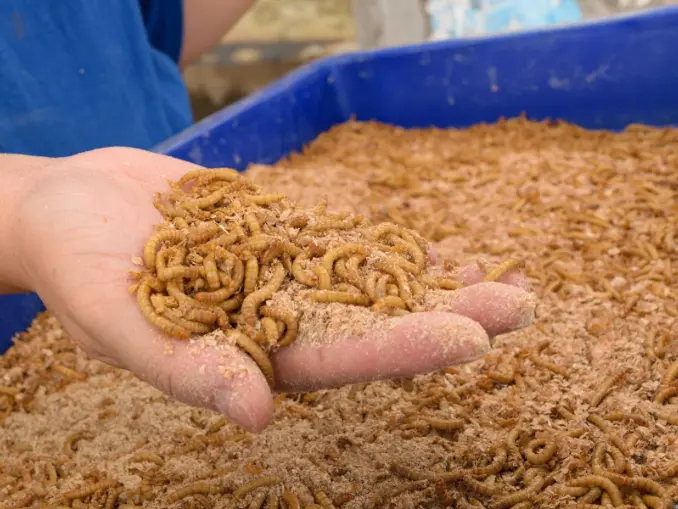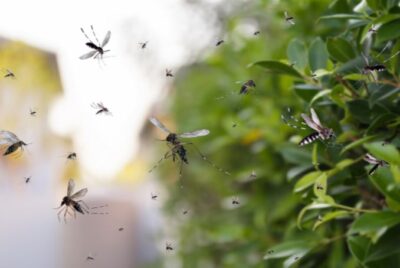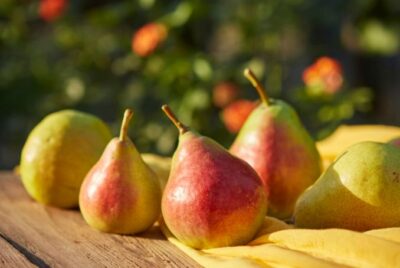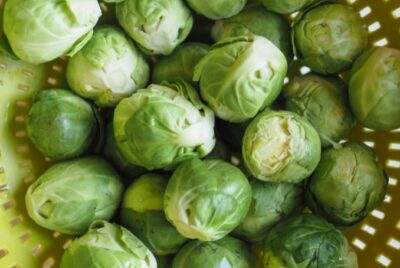Mealworms for Chickens: A Guide to Breeding and Benefits
Mealworms have long been a popular treat for backyard chickens, and for good reason. These nutritious insects are packed with protein and offer a range of benefits for your flock. In this comprehensive guide, we’ll delve into the world of mealworms for chickens, covering everything from breeding to the advantages they bring to your feathered friends.
What are Mealworms?
Mealworms are the larval stage of the mealworm beetle, Tenebrio molitor, a certain species of darkling beetle. They are widely used as a high-protein food source for various animals, including chickens, fish, reptiles, and birds. Mealworms are favored for their nutritional content, ease of breeding, and the benefits they offer as a supplement to the diets of these animals.
Life Cycle of Mealworms
The life cycle of mealworms consists of four stages: egg, larva (mealworm), pupa, and adult beetle.
- Egg (4-19 days): The cycle begins with the female mealworm beetle laying eggs. These eggs are tiny, about 0.5 mm in size, and are usually laid in the soil or decaying organic matter.
- Larva (Mealworm) (10 weeks): After hatching, the eggs turn into larvae, which are what we commonly refer to as mealworms. This stage can last several weeks to several months, depending on environmental conditions such as temperature and humidity. During this time, mealworms are voracious eaters, consuming a diet of grains, decaying leaves, and dead insects. They will molt multiple times, shedding their exoskeleton to grow.
- Pupa: After the larval stage, mealworms enter the pupal stage. During this time, they do not eat as they transform into adult beetles. This stage can last from a couple of weeks to a month, again depending on environmental conditions.
- Adult Beetle: After emerging from the pupal stage, the organism becomes an adult darkling beetle. Adult beetles can live for a few months, then reproduce and lay eggs, starting the cycle anew.

Are Mealworms Good for Chickens?
Mealworms are excellent for chickens. They are a high-protein snack that supports healthy growth, feather development, and egg production. The protein content in mealworms is particularly beneficial during molting periods, aiding in the regrowth of feathers.
Additionally, mealworms provide essential nutrients, including vitamins and minerals, contributing to a well-rounded diet. Introducing mealworms into a chicken’s diet can also encourage natural foraging behaviors, offering mental and physical stimulation
Nutritional Value of Mealworms
- Protein: Mealworms are particularly valued for their high protein content. Live mealworms typically contain about 20-28% protein, while dried mealworms can contain up to 50% or more. Protein is crucial for growth, repair, and overall health.
- Fat: They also have a significant fat content, providing a good energy source. Live mealworms have around 13% fat, whereas dried mealworms can have around 25-30%. The high fat content in dried mealworms is due to the reduced water content.
- Fiber: Mealworms contain about 2-6% fiber, which is beneficial for the digestive health of animals.
- Water: Live mealworms have a high water content, around 62-65%, which is significantly reduced in dried mealworms to about 5-10%.
- Vitamins: They are a source of various vitamins, including B vitamins like B12, which are important for nervous system health, and antioxidants like vitamin E.
- Minerals: Mealworms provide essential minerals such as calcium, phosphorus, magnesium, potassium, sodium, and iron, which are crucial for bone health, nerve function, and overall cellular processes. Their mineral composition per 100g typically includes calcium (42 mg), iron (3.8 mg), zinc (4.2 mg), manganese (0.44 mg), and copper (0.78 mg).
- Other Nutrients: They also contain other beneficial compounds, such as selenium, known for its antioxidant properties.

Benefits of Mealworms to Chickens
A Protein-Rich Diet for Chicken Robust Health
Chickens need a well-balanced diet to stay healthy and productive. Mealworms are an excellent source of protein, making them an ideal supplement to their regular feed. Protein is crucial for muscle development, feather growth, and overall vitality in chickens. By adding mealworms to their diet, you ensure that they receive the essential protein they need to thrive.
Mealworms Enhance Chicken Egg Quality and Production
If you keep chickens for their eggs, mealworms can play a significant role in improving egg quality and production. The high protein content in mealworms not only helps hens maintain good health but also supports the formation of strong eggshells. Additionally, the extra protein can stimulate increased egg-laying, leading to a higher yield of fresh eggs.
Mealworm Diet Supports Chickens During Molting
Molting is a natural process in which chickens shed old feathers and grow new ones. It can be a stressful period for chickens, often resulting in reduced egg production and weakened birds.
Feeding mealworms during molting can be beneficial as the protein aids in feather regeneration and helps chickens recover faster. This means less downtime and quicker returns to peak productivity.
Mealworms Help in Bedding Management and Environmental Benefits
Chickens are known to scratch and dig in their bedding, which can lead to a messy coop. Mealworms provide a natural distraction, keeping your chickens engaged and reducing their inclination to disturb the bedding. This can lead to cleaner and more sanitary living conditions for your birds, promoting their overall health.
Additionally, mealworms can help in breaking down waste in the coop, contributing to better waste management.
Entertainment and Foraging
Chickens are naturally curious and love to forage for insects and grubs. Feeding mealworms to chickens not only meets their nutritional needs but also offers them entertainment.
Watching chickens hunt and peck for mealworms can be a source of amusement for poultry keepers. It’s a win-win situation, providing both mental stimulation for your chickens and a source of joy for you.

How to Raise Mealworms for Chickens
Step 1: Gather Supplies
Before you start, gather the necessary supplies:
- A container: You’ll need a suitable container to raise your mealworms. A plastic storage tote or an old aquarium works well. Ensure it has a lid or screen mesh for ventilation.
- Substrate: Wheat bran is an ideal substrate for mealworms, but you can also use rolled oats, chicken mash, or cereal crumbs.
- Mealworms: Purchase mealworms from a reputable local source or bait shop to start your colony.
Step 2: Set Up the Container
- Clean the container thoroughly and allow it to dry completely.
- Find a suitable location for the container. It should be in a warm area with a consistent temperature of around 80°F. Low light or darkness is essential for mealworms, so consider using a closet or covering the container to block out light.
- Create a lid or cover for the container that allows for adequate air circulation. You can use wire mesh or aluminum foil with holes poked in it.
Step 3: Add Substrate
Fill the container with the chosen substrate to a depth of about 2-3 inches. If you use wheat bran, make sure it’s been sterilized by spreading it on a baking tray and baking it in the oven for 20 minutes at 130-150°F. This helps eliminate pests and ensures a clean environment.
Step 4: Introduce Mealworms
Now, it’s time to introduce the mealworms to your container. Aim to start with at least 500 mealworms. Gently pour the mealworms into the container and cover it to prevent their escape.
Step 5: Feeding and Maintenance
- Provide a continuous supply of food for your mealworms. You can feed them various kitchen scraps like fruit and vegetable peels, as well as slices of potato. Make sure not to overfeed, as excess moisture can lead to mold.
- Maintain the substrate depth at around 3 inches by adding more substrate as needed every couple of weeks.
- Keep the container in a dark or low-light environment, maintaining a consistent temperature of around 80°F. If you’re in a colder climate, consider using a reptile heat mat with a programmable thermostat to regulate the temperature.
- Regularly remove any moldy food from the container to prevent contamination.
Step 6: Harvesting Mealworms for Chickens
It will take a few months for your mealworm colony to mature. You can start harvesting mealworms once they’ve reached the desired size, typically around 1 to 1.5 inches long.
To collect mealworms for your chickens, place a piece of vegetable, like a carrot or potato slice, into the container. Wait for a few minutes, and the mealworms will crawl onto it.
Lift the vegetable out and shake it over another container to separate the mealworms. Your chickens can enjoy these freshly harvested mealworms as a tasty treat.
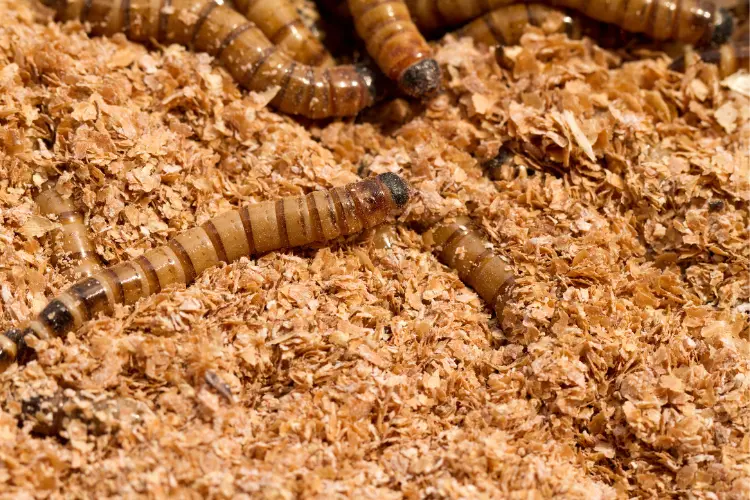
Tips and Tricks For Growing Mealworms for Chickens
Environmental Considerations:
- Place a thermometer and hygrometer in the breeding box.
- Protect mealworms from direct sunlight during the summer.
- Avoid positioning containers near heat sources to prevent dehydration.
Hatching Conditions:
- Temperature and humidity affect hatching time.
- 25-30°C with 50-70% humidity: 7-10 days for hatching.
- 15-20°C with 40-60% humidity: Approximately 30 days.
- 0-10°C with 40-60% humidity: Insects enter dormancy and do not hatch.
Feeding:
- Use hard vegetables like carrots or apples every 3-5 days.
- Avoid leafy vegetables as they dry out quickly.
- Adjust food quantity based on mealworm size.
Temperature and Humidity:
- Maintain 26-32°C for optimal growth; extremes can be harmful.
- Humidity around 70% is ideal; too low can slow growth, too high can lead to diseases.
Dietary Considerations:
- Mealworms are omnivorous and eat grains, oilseeds, and vegetable leaves.
- Provide a diverse diet with a mix of feeds to meet nutritional needs.
Behavioral Traits:
- Mealworms are photophobic, so provide dim lighting.
- Avoid overcrowding, as it can lead to heat-related deaths.
Breeding Methods:
- Adult breeding involves transferring beetles to breeding containers.
- Maintain a male-to-female ratio of 1:1.
- Use wooden containers with wire mesh at the bottom.
- Cover the bottom with paper for egg-laying.
- Remove adults after three months of continuous egg-laying.
Raising Young Larvae:
- Separate young larvae from eggs in a well-ventilated container.
- Maintain suitable temperature and humidity levels.
- Start with finely ground feed and transition to coarser feed.
- Keep bedding clean and dry, and avoid overcrowding.
Harvesting Mealworms:
- Harvest at different stages based on intended use.
- Use sieving to separate mealworms from a substrate.
- Clean and sort harvested mealworms.
- Store in a ventilated container at 10-15°C to extend shelf life.
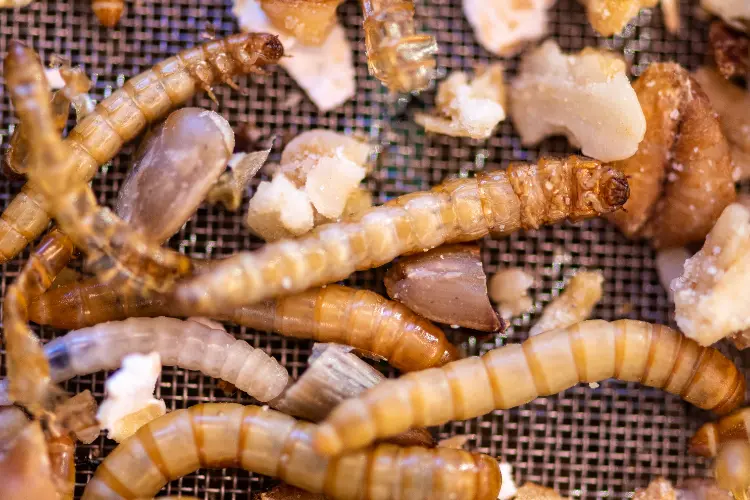
How Many Mealworms Should Chicken Eat
Feeding chickens 10-12 mealworms daily can be a good guideline for providing them with this nutritious treat. Mealworms are high in protein and can be a valuable addition to their diet.
However, it’s essential to remember that mealworms should be considered a treat or supplement and not the primary source of nutrition for chickens. Their primary diet should consist of a balanced chicken feed that meets all their nutritional requirements. Overfeeding mealworms or using them as the sole food source can lead to nutritional imbalances.
So, offering 10-12 mealworms per day as a treat is a reasonable amount to provide some variety and extra protein to your chickens’ diet while ensuring they get their essential nutrients from their regular feed.
Read also: Best Bugs and Insects for Chicken Nutrition
Do Chickens Prefer Live or Dried Mealworms?
Live Mealworms
Live mealworms are a dynamic and enticing treat for chickens. Chickens are natural foragers, and live mealworms cater to their instinctual desire to chase and catch moving prey.
The wriggling motion of live mealworms can make them more appealing to chickens, sparking excitement and engagement during feeding time. Chickens often find the process of hunting live mealworms enjoyable, which can provide mental stimulation.
However, it’s important to note that live mealworms are more perishable and require appropriate storage conditions to maintain their freshness, such as a cool and dark environment. Offering live mealworms can be a great way to enrich your chickens’ feeding experiences and keep them entertained.
Dried Mealworms
Dried mealworms are a convenient and practical option for chicken owners. They have a longer shelf life and are easier to store than their live counterparts. Dried mealworms are typically sold in a ready-to-feed form, making portion control simple.
Some chickens may prefer dried mealworms because they are easy to consume and have a crunchy texture. These dried treats are a convenient way to supplement your chickens’ diet with extra protein and nutrition.
While they may lack the interactive aspect of live mealworms, dried mealworms offer a hassle-free and consistent way to provide your chickens with a tasty and nutritious treat.
Mealworms for Chickens Final Thoughts
Mealworms are a fantastic addition to your chickens’ diet, offering a plethora of benefits from improved nutrition to enhanced egg production and environmental advantages. Breeding mealworms for your flock is a rewarding endeavor, providing a constant supply of these nutritious treats.
By following the breeding guide and understanding the benefits, you can ensure your chickens lead happy and healthy lives while enjoying the occasional mealworm treat.

